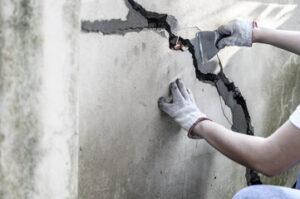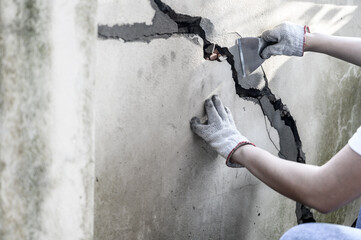While natural aging and wear will eventually degrade concrete, regular restoration can prevent problems from becoming major structural repairs. It is much more cost-effective to repair damage like cracks before they become serious enough to threaten the integrity of floors, walls, and support structures.
Repairing concrete requires the right material and skill to get the job done. The main objectives are to create a strong bond and stop water from flowing through active cracks. For professional help, contact Concrete Contractors Dallas TX.
Concrete repair does not require special skills or prior experience; with the right products, you can tackle a variety of minor projects on your own. For a more major overhaul, however, you will need to employ good construction practices in order to achieve proper bonding between the old concrete and the new concrete.
The preparation phase is a key element in all concrete repairs. This is because the quality of your final repair depends on how well the new materials adhere to the existing concrete. The best way to ensure this is by using the correct surface preparation, which may include chemical cleaning, acid etching, or abrasive methods.
All concrete surfaces are susceptible to deterioration and degrade with age, weathering, or use. This can be due to natural aging, corrosion from repeated exposure to the elements, or impact damage from vehicles, machinery, or tools. Corrosion is typically accelerated by water penetration, which can degrade the surrounding concrete and lead to structural failures.
To prevent this, all surfaces should be thoroughly cleaned before attempting concrete repairs. Sweeping, vacuuming, and hosing off the surface is adequate for most situations, but the concrete should also be free from loose material such as chips and sand. Chemical cleaners like tri-sodium phosphate or detergents are not recommended for concrete repairs, as they can cause contamination to be carried deeper into the concrete structure. Acid etching is a common method for cleaning and surface preparation, as it can remove the normal amount of dirt from concrete, but the process does not destroy the aggregate.
It is crucial that the existing concrete is damp before attempting any concrete repair. If it is not, the new material will pull moisture from the existing concrete and weaken the resulting bond. Unless your repair material specifies otherwise, you should also keep the surface damp for an extended time after application.
This will reduce shrinkage, which can cause the repair to loosen and crack again. If you are unable to do this for an extended period, it is better to move on to another repair option.
Mixing
Concrete repair procedures must meet several important objectives to succeed. These include achieving good bonding with the existing concrete, providing high strength, load-carrying capacity, and durability. Ideally, the repair should also be economical in both initial cost and service life. Many ready-mix and bagged concrete mix manufacturers are designing their products to achieve these goals by adding additives and adjusting their formulations. Some, like Quikrete, have added fibers, polymers, and other admixtures to help reduce cracking and improve flexural and abrasion resistance.
The first step in most concrete repairs is to remove any loose material and chip away any unsound concrete in the area of the damaged surface. Then, the contractor must thoroughly wet and brush down the existing surface to a sound base. Depending on the situation, a contractor may need to saw-cut any existing concrete that is severely cracked or deteriorated.
Next, the contractor needs to prepare the area for the new repair by blowing or vacuuming it clean and then preparing it for a standard repair mixture. Typically, the standard repair mixture will be a concrete mortar mix that is made from one part Portland cement, three parts masonry sand, and enough water to make a thick paste. The manufacturer’s recommendations will indicate how much water to use and how much sand should be included in the mix.
A good-quality commercial-grade repair mortar mix should have no or very low drying shrinkage. Drying shrinkage can debond the repair and cause cracking. Other characteristics that are important in a good repair include freeze-thaw resistance, elastic modulus, and thermal coefficients.
Contractors should always carry a long level in their toolbox. They should saturate (but not drench) the repaired surface and then apply the concrete repair mix using a mason’s trowel or putty knife. They should be careful to fill all cracks and holes and tap the surfaces properly to remove air pockets.
A final step is to smooth the repair surface and, if needed, texture it to match the surrounding existing concrete. A good texture will also increase the longevity of the repair.
Applying
Concrete is a durable and highly functional material, but it can deteriorate over time. Fortunately, most problems that occur in concrete can be repaired using specially designed patch and repair products.
Before applying any concrete repair material, it is important to assess the structure of the concrete and determine its level of deterioration. The structural integrity of a concrete surface can be compromised due to cracking, honeycombing, and spalling. In some cases, these damages can lead to the collapse of a building.
It is essential to recognize these issues and take action quickly. If left unattended, even seemingly minor damage can cause serious safety and security concerns for employees and pedestrians.
Contractors should also evaluate the concrete to see if it has been damaged by moisture, salt, or other environmental factors. For instance, if a concrete slab has been exposed to carbon dioxide or chloride for extended periods of time, it could be vulnerable to the corrosion of steel reinforcement within the concrete.
Once a contractor has determined the condition of the concrete, they should prepare the area for the application of the repair product. This includes removing any existing concrete, cleaning the concrete, and clearing away any debris. Contractors should also spray the area with water to dampen it, especially if it is a warm day. This will help the new concrete repair materials bond properly with the existing concrete.
Concrete suppliers often provide valuable insight on the selection of the right repair materials for any job. For example, Quikrete offers a superior sanded acrylic latex formulation that can be used for repairs on concrete, stucco, or masonry walls and sidewalks. The product has been formulated to be highly adhesive and to stay bonded to the concrete for the life of the product.
Many manufacturers offer a variety of concrete repair materials with different levels of strength and durability. Some have polymers added to the basic Portland cement and aggregate mixture, which leads to higher bond strength and durability. These products can typically be used for both structural and cosmetic repairs.
Finishing
Concrete is one of mankind’s most durable and versatile building materials, but it can be damaged over time. The concrete repair process fixes deteriorated surfaces and prevents future damage. A variety of commercially available patch and repair products can help with most repairs, but a skilled professional is best suited for larger jobs.
It’s almost always easy to see when a concrete surface is experiencing problems such as cracking and honeycombing. However, recognizing the problem is often not the same as determining the cause. The structural integrity of a concrete structure may be compromised by improper construction methods, moisture exposure, and even aging. It is important to identify the root causes of a problem and correct them before starting any repairs.
When a structural slab has a flaking or spalling problem, the first step is to remove the loose material. This can be accomplished by chipping or sawing the affected area to clear out the voids, then filling them in with standard repair material.
After the concrete repair is completed, it should be allowed to set up for several days. During this period, it is important to protect the freshly applied concrete from the sun or wind, which can affect its strength and durability. Using a burlap sheet or plastic covering to cover the repaired area and taping the edges is an effective method.
Once the repair is set, it’s important to finish it correctly to maintain its appearance and prevent future deterioration. The use of a power trowel or other type of finishing tool can make the concrete smooth and attractive. Concrete surface treatments are also available to protect the concrete and slow the rate of its deterioration.
A quick and economical solution to repairing small cracks in concrete is to apply dry cement powder to the affected area. This will hydrate and fill the cracks, making them less noticeable. Alternatively, using a concrete bonding adhesive or high-strength patching product will result in a stronger and more visually appealing repair.
A newer repair method is to use a high-strength, low-powder cement. This product will bind the concrete and reduce surface cracking, making it more resistant to environmental factors such as rain, freezing temperatures, and salt water. It can be applied by hand or with a sprayer and is often used in parking garages and other industrial areas where the concrete will be exposed to vehicles and chemicals.

